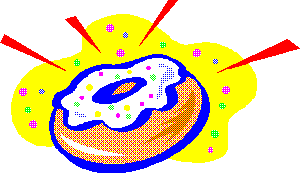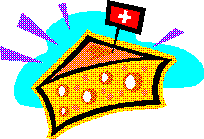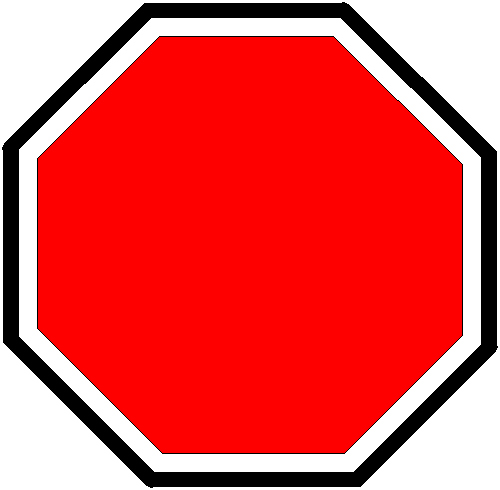
Part II of Lesson 6: the exercise
The Supply Store
Back to YouCan Draw.Com
Introduction
to Lesson 6: |
In this lesson: Today we're going to concentrate on something you were introduced to in the last lesson: negative space and it's undervalued importance in drawing. You'll learn in this lesson how to recognize and make better use of all parts of a composition. On the second page of this lesson (the exercise page) there'll be an animation to help drive home the point about format, positive objects, and negative space. "Wait a second, what's all that stuff?" I hear you saying. Well that's the first thing on today's itinerary - I'm going to introduce you to four new terms: Composition, format, negative space and positive form.

The hole in the donut is real! Well sort of
Four new terms
Positive objects: are the things you draw: people, faces, people's features, cars, kitchen utensils, - literally anything you can put your hands on or put a name to.
Negative space: the space, the nothing around and within the objects you're drawing.
Format: the "bounded" area you're drawing in - like the 8 1/2" x 11" piece of paper you're reading this on if you printed it out. Like the frame around a painting, or the shape you see containing your subject when you look through a camera viewfinder (usually rectangular or square). You can think of the pages of a book as the format for the text: all the text and pictures are written within the edges of the paper. Like an aquarium holds all the fish.
Return to lesson 8 , exercise 1 "Homework" in sighting; ignore this if you're seeing Lesson 6 for the first time.)
Composition: A composition is nothing more than the arrangement of positive objects and negative spaces within the format.
To further plant these terms in your head, watch this animation - if it doesn't make much sense the first time through, that's ok. By the time you get through the exercises at the end of the next page, it'll be clear.
Chair / format / negative space / animation
Negative Space |
 Remember when you did the
modified contour drawing of your hand? Recall when I
asked you to look for a space between your crossed
fingers? (Crossed finger example). The point of that was to get you building an
awareness of drawing things that aren't there, making
something of the nothing. Like the holes in the Swiss
cheese, or a middle of the donut, they aren't anything
physical you can put your hands on, but they do have a
describable shape: that is you can draw them. They help
define the object you're drawing. This isn't how we
normally approach things in the world.
Remember when you did the
modified contour drawing of your hand? Recall when I
asked you to look for a space between your crossed
fingers? (Crossed finger example). The point of that was to get you building an
awareness of drawing things that aren't there, making
something of the nothing. Like the holes in the Swiss
cheese, or a middle of the donut, they aren't anything
physical you can put your hands on, but they do have a
describable shape: that is you can draw them. They help
define the object you're drawing. This isn't how we
normally approach things in the world.
Why this isn't normal
The idea of paying attention to what isn't there, placing the emphasis on the "nothing" is foreign to our normal thinking. When we were kids our parents calmed us at night by saying "there's nothing in the closet - and if there' nothing in the closet, then nothing can't hurt you". In drawing, and I hope no one regresses to their childhood when I say this, but "nothing is real" - nothing is as much a part of the picture as is the object we're trying to draw (or paint or sculpt).
Why the difficulty respecting Negative Space?
As we grew up, we learned new words, we learned to apply them to things or actions or emotions. The words soon came to symbolize the things we talked or thought about. That was a Left hemisphere or L-mode activity. That is, if I say "U.S.S. Enterprise" you'll most likely think of a Navy ship. Or if I say "Space shuttle", or "Ford Bronco", or "lipstick" or "baby" all of these conjure up the picture of a specific thing.
The word isn't the thing, but over time we attach a meaning to the word or the symbol and we pretty much know what we're referring to. In fact, in our brains, we can become almost attached to a word as we are to the real thing - we confuse the two. People with phobias will attest to this. Just mention "snake" to a person with a snake phobia and his body, his physiology will begin ro react (rapid pulse, sweating, anxiety, etc.). The word becomes the symbol and the symnbol becomes the container of everything our minds associate it with. Symbols work great for "readin' writin' and 'rithmatic" or setting off phobias. Mathematics and language, written or spoken, can't operate without symbols.
It's this object centeredness, the bias we have towards the thing we're drawing or speaking about, that makes it difficult for us to focus on the negative space, the spaces around it - until we make room for it.
(A mini-history of our bias towards "things")
Unlearning an Old Habit
So when we draw, unless we're trained otherwise, our attention is on a specific object out there in the world. Unless you're trained to see as an artist, you haven't been trained to see negative space. Culture doesn't work that way, in fact our brains don't work that way. L-mode must be able to quickly identify and categorize things or it gets impatient, and tries to ignore them or pass them off. Things like "negative space" is extra information. Extra information isn't vital, and our mind is trained to be pretty efficient when it comes to dodging arrows. (It's the arrows that do the damage - not the space around them.)
And since we've never given much thought to negative space, that is we've never been required to give much thought to it, we're at a loss when it comes to talking about it. So, we've got few words to deal with it and we certainly don't look for it.
And this is perfect. Because this confusion over what's nameable and what isn't allows R-mode a place to enter. And as you know by now, R-mode was built for dealing with unknown, unnamed territory. So in this lesson I want to train you to see the non-object, the "negative space" part of the picture as much as the object.
"So what is the Nothing, what do I look for?"
As a warm-up, look at any portrait or your own family photos. Is there a space between your head and the next person? Or a space between your body and the background? Are you set against a Colorado sky - just you surrounded by that gorgeous purple sky on the top of Vail mountain? Or is there a hazy city behind you: a backdrop of skyscrapers, street lights, a street disappearing into the horizon? The Grand canyon? All of those backgrounds or backdrops are examples of negative space. They're not the only kinds of negative space, but they give us an easy way to picture negative space.
We're generally not concerned with the space that surrounds our money, or our loved ones, or what we're drawing, (unless someone is invading our/their space), and if you think of "outer space" it's difficult to think of it without thinking of planets and comets and "Buzz" Aldrin floating out there in the middle of blackness. It's the that blackness of deep space forms the backdrop, "the other than the object we're looking at" negative space.
Imposing boundaries
As an aid in recognizing and even creating negative space, we need to put boundaries around what we're trying to draw. And those boundaries are called once again, "formats".
Don't worry, you'll have this nailed down before this lesson is over. There's lots of examples below. That surrounding space and the recognition of it, will boost the quality of your compositions as much as any one skill.
Tell Me again, What's a format?

A format is the frame, the bounding space we place around our compositions - the format contains the composition. Paintings and draw- ings you see in a museum are formatted, for the most part, in a rectangle. If you look through a camera, you generally place the person or thing you're photographing the middle the camera's viewfinder. It's through the viewfinder you format your subject. Most camera viewfinders are square or rectangular. Microscopes, and telescopes and binoculars format the subject within a circle.
Highway Signs - unusual formats
A roadside "Yield" sign formats it's message triangularly; a "Stop" sign in a hexagon. We take this for granted. In learning to draw, special attention to the format will allow your realistic rendering ability to leapfrog in giant bounds.
Another Example of "format" in
Music
You musicians will recognize this. In blues, most songs fit within a 12 bar or 16 bar time pattern. Bars are just a measure of time. This is a format in time. That is, the number of beats or bars (amount of time) needed to go through a whole progression of the song is set down beforehand. Even in free-form jazz, there's a format people follow. Without some imposed order, through chord arrangement or in timing, the music becomes random. And that randomness regresses into chaos. The music needs to fit within its parameters. Those parameters are its format, and that format imposes limits.
Back to Drawing
Format in music is built around time. Format in drawing is built around space. Most drawing students (me included), make little investment in regarding the format. We're concerned with the object. Kids quite unconsciously use the format of the paper: they put a house in the middle, the sun in an upper corner, trees placed evenly, maybe a bird, and put their brothers, sisters and parents in the middle. They got a great natural sense of composition - they utilize the whole space they're drawing in. Here's a dinosaur masterpiece in a rectangualar format by Patrick McGrath of Minnetonka, MN demonstrating many of these fine points:

"T-Rex eating man" by Patrick McGrath
The amazing thing is this: the format is a huge help in drawing anything! Put a format around something, and it allows us to limit what we see. It "frames" the object and the negative space around it. Now we just need to learn to give the negative space as much respect as the "positive" object.
| Try
this. Roll up a newspaper or any piece
of paper. Look through it as if you were looking
through a telescope. Look at the paintings or
drawings in your house. They're framed by a
rectangle or square most likely. Look at them now
through a rolled up newspaper the way Captain
Nemo looks through his telescope. You now have a circular format around everything you look at. So I hope the point is clear. If not, you'll have it soon enough by doing some of the upcoming exercises. |
 |
How Format Influences Your Compositions
So to put this all together, the format has a powerful influence in how you compose your composition: the positive objects complement the negative spaces within the format to unify the entire composition. How sensitive you are to all the elements within the drawing will influence how pleasing the composition is to look at. And this will start becoming clearer as you get practice working with negative space. So lets get to it!
Kasbohm & Company's
YouCanDraw.com
© Copyright, All rights reserved 1997
e-mail: jeffkaz@YouCanDraw